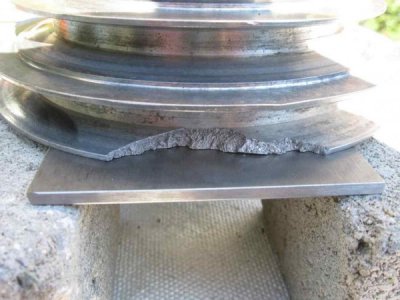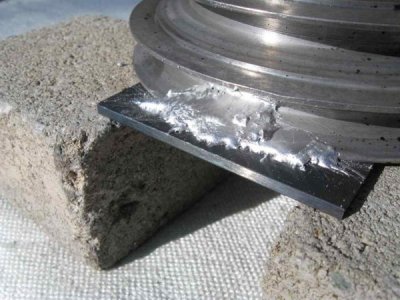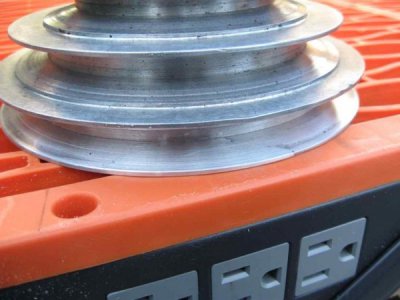- Joined
- Sep 22, 2010
- Messages
- 7,223
Aluminum Pulley Repair
published with permission of Mike Slater
Hi all,
I was faced with the challenge of repairing a chipped aluminum pulley - thought folks here might be interested in this approach.
A little background:
I recently aquired a multi-speed pulley assembly for a Southbend drill press I'm getting ready to restore.
Unfortunately the large pulley on the 4-step pulley had a large chunk missing.
Replacing this pulley was going to be difficult - so repair was the best option.
Since I don't have a TIG or MIG setup, I did some research and decided to try some of the low temp aluminum rods. (I chose Durafix - there are others)
These are an aluminum alloy that melts somewhere in the 750 deg range. It really goes on more like solder but is very strong.
I practiced on a spare broken pulley before trying this on the important piece. (PRACTICE FIRST!!!)
The results are better than expected.
A steel piece was placed on the back side of the pulley as a form - the Durafix will not stick to steel.
I used a regular torch running MAP gas. Everything has to get to temp before the rod can be applied - then you basically "tin" the cracked area.
Once tinned you can keep adding rod to fill the area.
Let it cool naturally then use a belt sander to get to the rough shape.
I finished this on a lathe. After this is polished it will be practically invisible.
ATTACHMENTS


Better to overfill - its a pain to add more material after the initial "fix"

On my practice parts I used a propane torch but had a devil of a time keeping every thing hot.
On subsequent practice parts I developed the technique shown in the photos.
CLEAN the part well - oil even from your hands screws things up
1/8" steel backing - anything thinner warps as heat is applied.
Steel is supported on the ends only to keep heat transfer at a minimum.
With these 2 techniques and the MAP gas I was able to get and keep everything hot.
This pulley was pretty large - probably 6.5" at the large end and a fair amount of metal in the middle for bearings. Plus the break covered a large area.
[Re: Writeup on pulley repair
Mike slater Feb 23 at 10:13 PM
Hi Nels,
No problem - happy to share.
Mike
May I post it on H-M to share with our SBDP owners?
Nels]
published with permission of Mike Slater
Hi all,
I was faced with the challenge of repairing a chipped aluminum pulley - thought folks here might be interested in this approach.
A little background:
I recently aquired a multi-speed pulley assembly for a Southbend drill press I'm getting ready to restore.
Unfortunately the large pulley on the 4-step pulley had a large chunk missing.
Replacing this pulley was going to be difficult - so repair was the best option.
Since I don't have a TIG or MIG setup, I did some research and decided to try some of the low temp aluminum rods. (I chose Durafix - there are others)
These are an aluminum alloy that melts somewhere in the 750 deg range. It really goes on more like solder but is very strong.
I practiced on a spare broken pulley before trying this on the important piece. (PRACTICE FIRST!!!)
The results are better than expected.
A steel piece was placed on the back side of the pulley as a form - the Durafix will not stick to steel.
I used a regular torch running MAP gas. Everything has to get to temp before the rod can be applied - then you basically "tin" the cracked area.
Once tinned you can keep adding rod to fill the area.
Let it cool naturally then use a belt sander to get to the rough shape.
I finished this on a lathe. After this is polished it will be practically invisible.
ATTACHMENTS


Better to overfill - its a pain to add more material after the initial "fix"

On my practice parts I used a propane torch but had a devil of a time keeping every thing hot.
On subsequent practice parts I developed the technique shown in the photos.
CLEAN the part well - oil even from your hands screws things up
1/8" steel backing - anything thinner warps as heat is applied.
Steel is supported on the ends only to keep heat transfer at a minimum.
With these 2 techniques and the MAP gas I was able to get and keep everything hot.
This pulley was pretty large - probably 6.5" at the large end and a fair amount of metal in the middle for bearings. Plus the break covered a large area.
[Re: Writeup on pulley repair
Mike slater Feb 23 at 10:13 PM
Hi Nels,
No problem - happy to share.
Mike
May I post it on H-M to share with our SBDP owners?
Nels]

